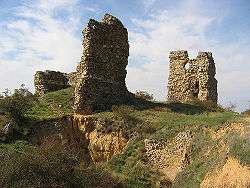Saldaña, Palencia

Saldaña is the principal town of the fertile Palencia plains in Spain, and may be the town of "Eldana" [1] mentioned by the historian Ptolemy as being conquered by the Roman Empire.
The town's connection to the Roman Era is reflected in the beautiful remains of a villa attributed to the emperor Theodosius I.
From the 10th to the 11th century, Saldaña was the seat of a family of powerful counts, the Banu Gómez. The medieval counts of Saldaña figure in local history and literature. Anachronistically, they appear in tales related to the exploits of the semi-legendary figure Bernardo del Carpio, while their legendary scions, the Infantes de Carrión, prove rivals of the hero in the Cantar de Mio Cid.
It was here in 1149 that Berenguela of Barcelona died.
Saldaña is also known for its popular open-air market day held each Tuesday in the town's central plaza.[2][3]
History
Without a doubt they are the counts of Saldaña, whose castles ruins still survive, those who fill the history and the local legend. The popular legend reminds us of Bernardo del Carpio, son of Sancho Díaz, count of Saldaña, and the princess Ximena, sister of Alfonso II of Asturias.The king, who opposed to their marriage, locked the count in a dungeon and sent his sister to the monastery.
Afterwards, was the head of the counts of Saldaña-Carrión whose earls, according to the muslim documents, belong to the family of Beni Gómez, being his first count documented Diego Muñoz. Vassal of the king of León during the century X, share his oriental border with the count of Monzón, which was finally distributed between the incipient county of Castilla and the own county of Saldaña-Carriuón. They exist documented sign where they affirm the participation of the counts of Saldaña-Carrión and of Castilla in various revolts against the kingdom of León taking advantage ages of debility of the sameone during the century X and they ended in the independence of the counts of Castilla
The 8 of March of 1126 pass away in the town of Saldaña the queen Urraca I of León, queen owner of Castilla and León and daughter of Alfonso VI of León, conqueror of Toledo. Later of her death, the corpse of the queen was taken to the city of León, where she received her funeral in the Panteón de Reyes de San Isidoro de León.[4]
In 1128, Alfonso VII of Castilla, son of Urraca I of León, and Berenguela of Barcelona contract marriage on the village, where had pleace the first bullfight documented. According to the chronicle of the time: “...where they married Alfonso VII in Saldaña with Miss Berenguela the girl, daughter of the earl of Barcelona, among other function, also where bullfights. Saldaña was the head for more than hundred places, manor of Marqués de Santillana and one of the training centre most important of the country. The old Gili-Zalan, later called Saldania, it became famous for their fights against Rome, whose domination was large and fertile. The surroundings testify, that was inexhaustible archaeological reef, in big part intact.
References
- ↑ Curchin, Leonard A. (2004-05-05). The Romanization of Central Spain: Complexity, Diversity and Change in a Provincial Hinterland. Routledge. ISBN 9781134451128.
- ↑ "Mercadillo de Saldaña". www.mercadillosemanal.com. Retrieved 2016-12-07.
- ↑ Javier Cardeñosa Laso (2011-02-28), Saldaña. Mercado de los Martes., retrieved 2016-12-07
- ↑ El Panteón Real de Las Huelgas de Burgos : los enterramientos de los reyes de León y de Castilla. Castilla y León (Spain). Junta. (2nd ed.). León, España: Junta de Castilla y León, Consejería de Cultura y Bienestar Social. 1990. ISBN 8424199995. OCLC 25260231.